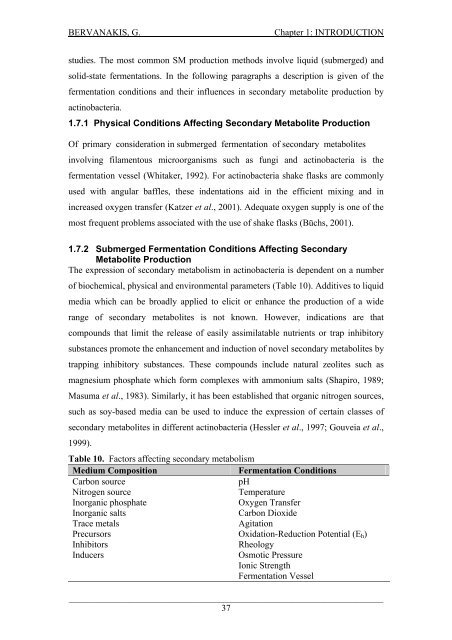Detection and Expression of Biosynthetic Genes in Actinobacteria ...
Detection and Expression of Biosynthetic Genes in Actinobacteria ...
Detection and Expression of Biosynthetic Genes in Actinobacteria ...
Create successful ePaper yourself
Turn your PDF publications into a flip-book with our unique Google optimized e-Paper software.
BERVANAKIS, G.Chapter 1: INTRODUCTIONstudies. The most common SM production methods <strong>in</strong>volve liquid (submerged) <strong>and</strong>solid-state fermentations. In the follow<strong>in</strong>g paragraphs a description is given <strong>of</strong> thefermentation conditions <strong>and</strong> their <strong>in</strong>fluences <strong>in</strong> secondary metabolite production byact<strong>in</strong>obacteria.1.7.1 Physical Conditions Affect<strong>in</strong>g Secondary Metabolite ProductionOf primary consideration <strong>in</strong> submerged fermentation <strong>of</strong> secondary metabolites<strong>in</strong>volv<strong>in</strong>g filamentous microorganisms such as fungi <strong>and</strong> act<strong>in</strong>obacteria is thefermentation vessel (Whitaker, 1992). For act<strong>in</strong>obacteria shake flasks are commonlyused with angular baffles, these <strong>in</strong>dentations aid <strong>in</strong> the efficient mix<strong>in</strong>g <strong>and</strong> <strong>in</strong><strong>in</strong>creased oxygen transfer (Katzer et al., 2001). Adequate oxygen supply is one <strong>of</strong> themost frequent problems associated with the use <strong>of</strong> shake flasks (Büchs, 2001).1.7.2 Submerged Fermentation Conditions Affect<strong>in</strong>g SecondaryMetabolite ProductionThe expression <strong>of</strong> secondary metabolism <strong>in</strong> act<strong>in</strong>obacteria is dependent on a number<strong>of</strong> biochemical, physical <strong>and</strong> environmental parameters (Table 10). Additives to liquidmedia which can be broadly applied to elicit or enhance the production <strong>of</strong> a widerange <strong>of</strong> secondary metabolites is not known. However, <strong>in</strong>dications are thatcompounds that limit the release <strong>of</strong> easily assimilatable nutrients or trap <strong>in</strong>hibitorysubstances promote the enhancement <strong>and</strong> <strong>in</strong>duction <strong>of</strong> novel secondary metabolites bytrapp<strong>in</strong>g <strong>in</strong>hibitory substances. These compounds <strong>in</strong>clude natural zeolites such asmagnesium phosphate which form complexes with ammonium salts (Shapiro, 1989;Masuma et al., 1983). Similarly, it has been established that organic nitrogen sources,such as soy-based media can be used to <strong>in</strong>duce the expression <strong>of</strong> certa<strong>in</strong> classes <strong>of</strong>secondary metabolites <strong>in</strong> different act<strong>in</strong>obacteria (Hessler et al., 1997; Gouveia et al.,1999).Table 10. Factors affect<strong>in</strong>g secondary metabolismMedium CompositionFermentation ConditionsCarbon sourcepHNitrogen sourceTemperatureInorganic phosphateOxygen TransferInorganic saltsCarbon DioxideTrace metalsAgitationPrecursorsOxidation-Reduction Potential (E h )InhibitorsRheologyInducersOsmotic PressureIonic StrengthFermentation Vessel_____________________________________________________________________37















